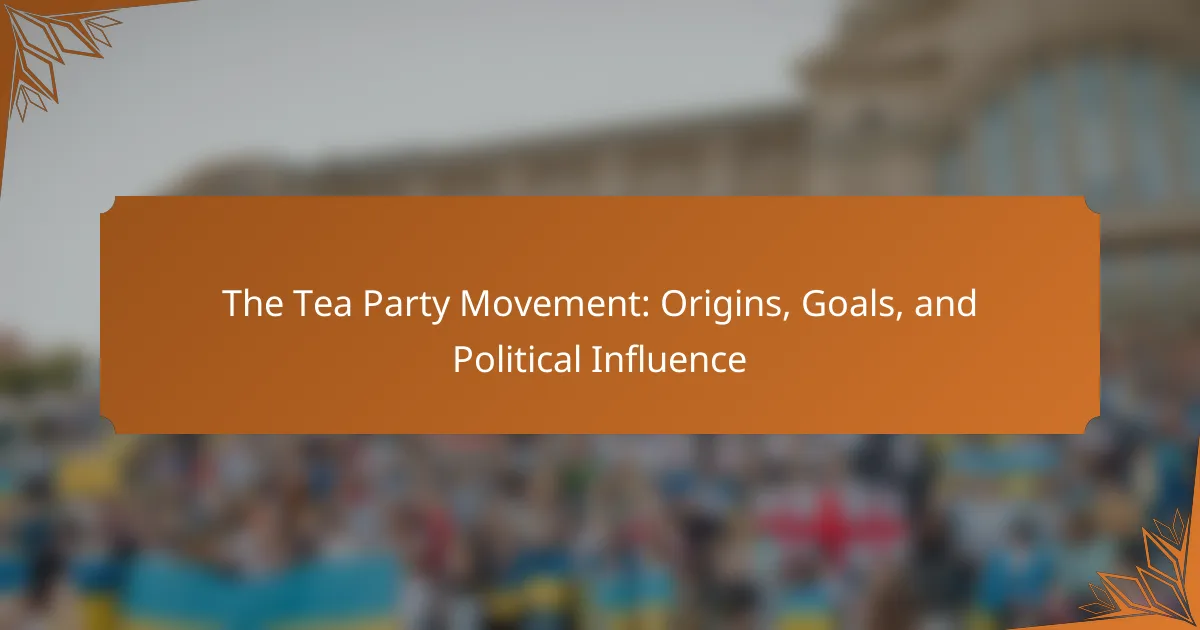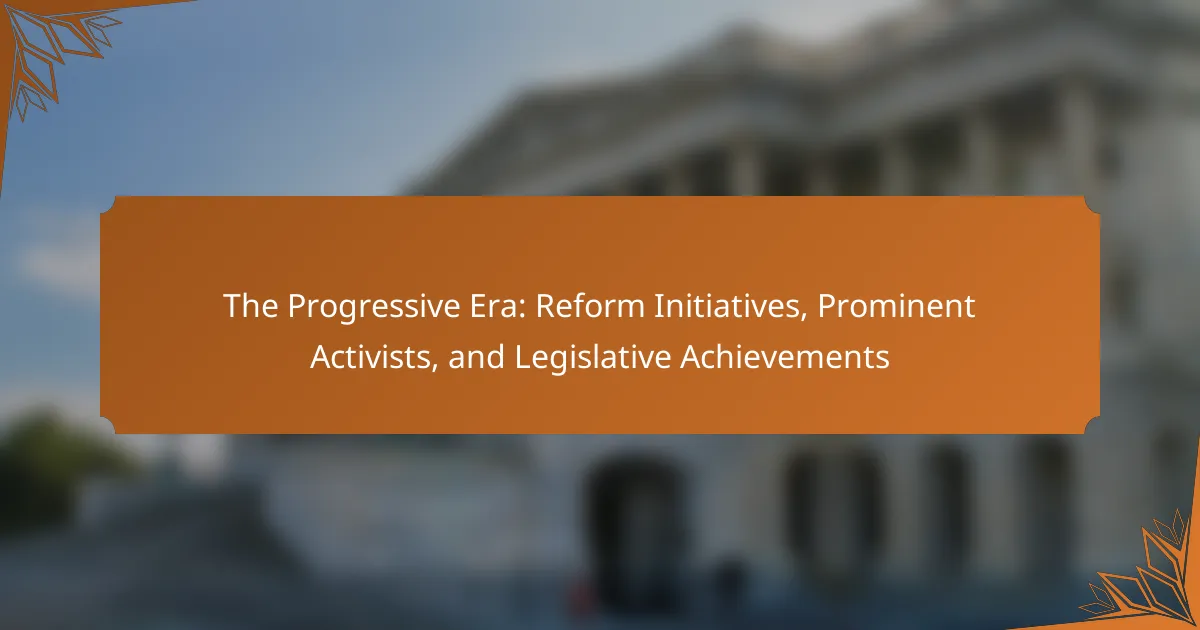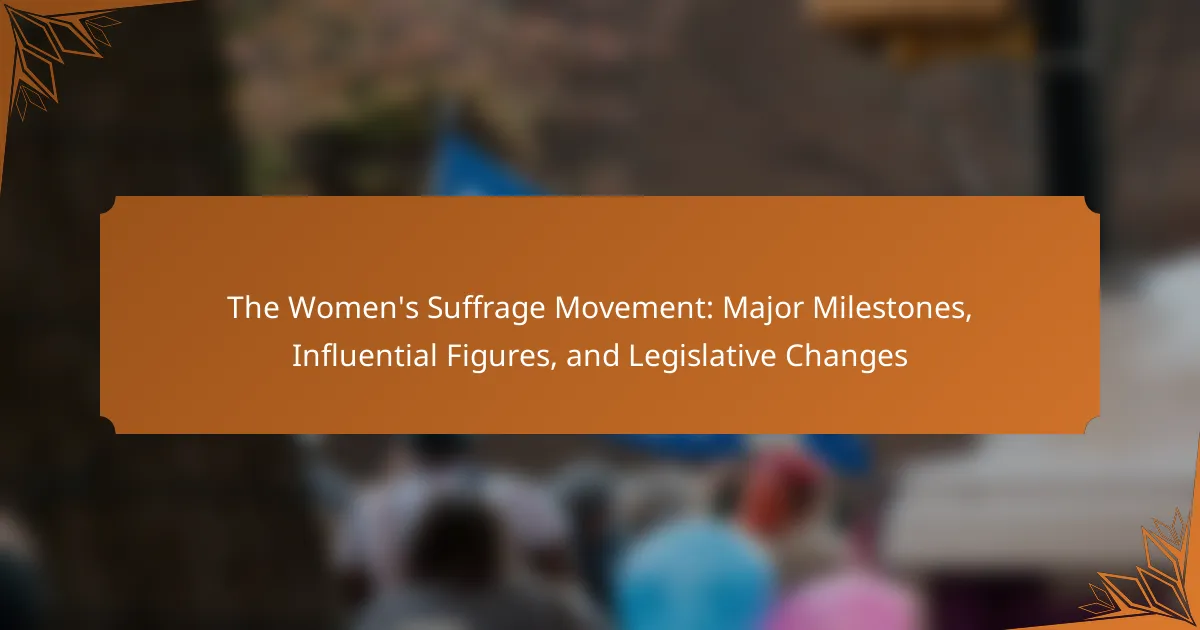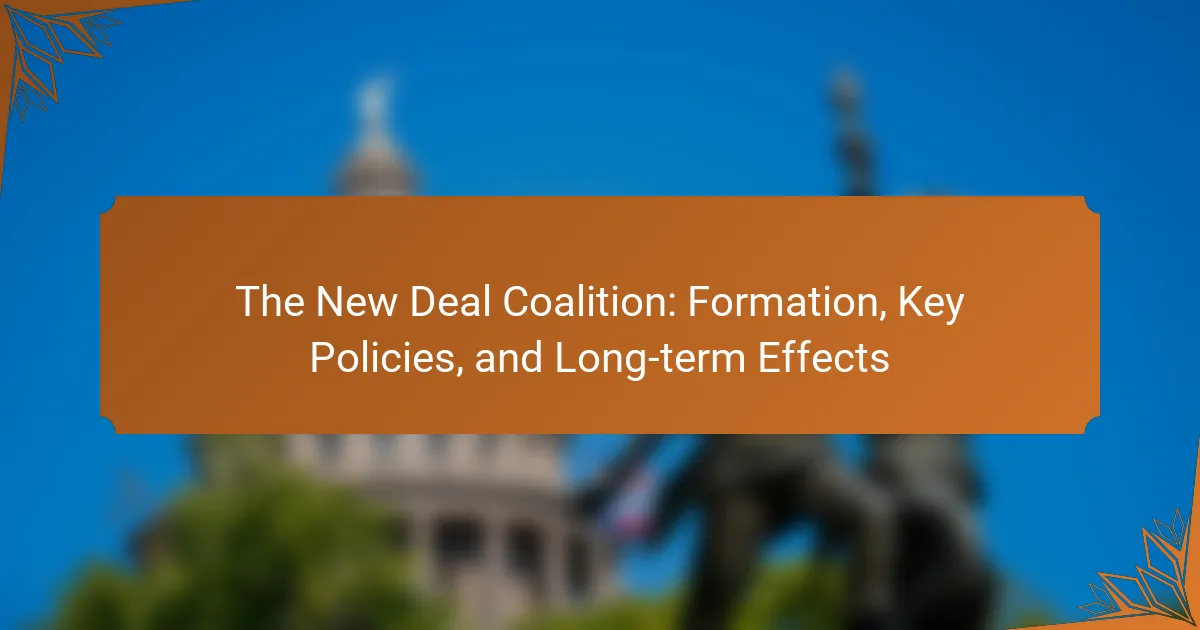The Tea Party Movement is a conservative political movement in the United States that emerged in 2009, primarily as a response to perceived excessive government spending and overreach. Its core goals include advocating for limited government, lower taxes, fiscal responsibility, and a strict interpretation of the U.S. Constitution. The movement gained prominence during the 2010 midterm elections, influencing numerous congressional races and shifting the Republican Party further to the right. Key activities associated with the Tea Party include grassroots activism, nationwide protests, and support for candidates aligned with its principles, all aimed at reshaping American political priorities and legislative agendas.
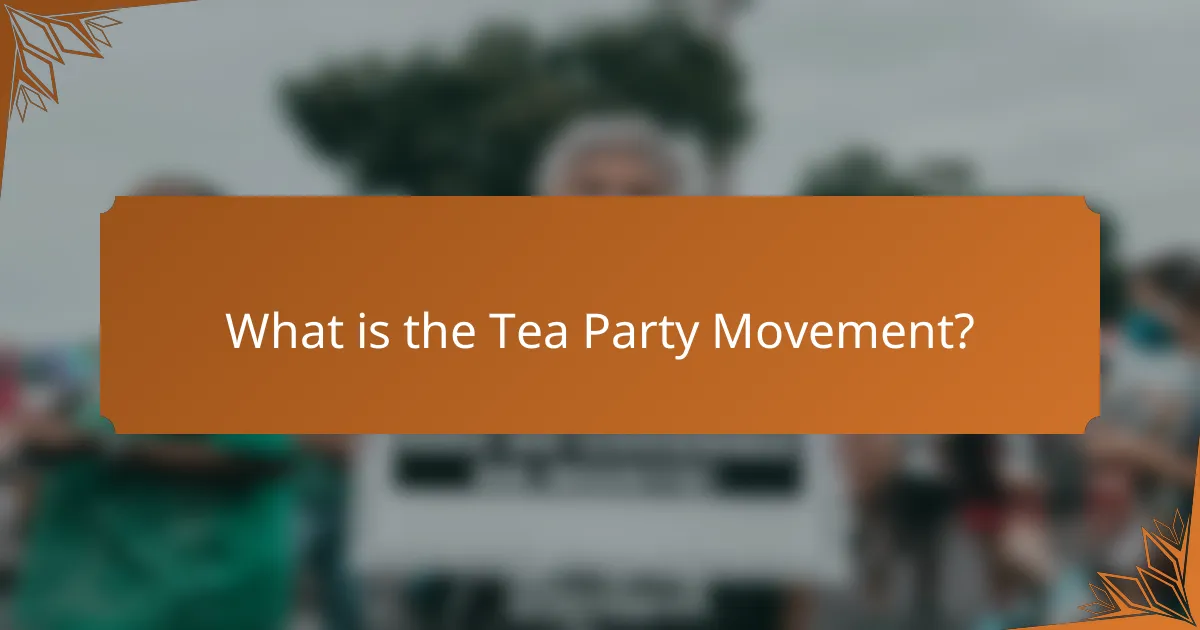
What is the Tea Party Movement?
The Tea Party Movement is a conservative political movement in the United States. It emerged in 2009, primarily in response to what participants viewed as excessive government spending and overreach. The movement is known for advocating for lower taxes, reduced government size, and a strict interpretation of the U.S. Constitution. It gained significant attention during the 2010 midterm elections, where it influenced numerous congressional races. The movement is often associated with grassroots activism and has been linked to the Republican Party. Key events include nationwide protests, particularly the tax day protests in April 2009. The Tea Party Movement’s impact on American politics includes reshaping the Republican Party’s policies and priorities.
How did the Tea Party Movement originate?
The Tea Party Movement originated in 2009 as a response to perceived government overreach and fiscal irresponsibility. It was sparked by the financial crisis and the election of President Barack Obama. Many individuals were concerned about high taxes and increased government spending. The movement gained momentum through grassroots organizing and the use of social media. Events like the Boston Tea Party in 1773 were referenced to symbolize their opposition to taxation. The movement quickly attracted attention from conservative politicians and media. By 2010, it had become a significant force in American politics, influencing the midterm elections. The Tea Party’s emphasis on limited government and individual liberties resonated with many voters.
What historical events led to the formation of the Tea Party Movement?
The Tea Party Movement formed in response to several historical events. The 2008 financial crisis sparked widespread discontent among Americans. This crisis led to increased government spending and intervention, specifically through the Troubled Asset Relief Program (TARP). Many citizens viewed these actions as government overreach. The election of President Barack Obama intensified these feelings. His administration’s policies, such as the Affordable Care Act, faced significant opposition. In early 2009, CNBC correspondent Rick Santelli called for a “Chicago Tea Party” on live television. This sparked grassroots organizing efforts across the nation. Local groups began to form, advocating for limited government and fiscal responsibility. The movement gained momentum through rallies and protests, particularly in 2009. These events collectively contributed to the emergence of the Tea Party Movement as a significant political force.
Who were the key figures involved in the early stages of the Tea Party Movement?
Key figures involved in the early stages of the Tea Party Movement include Ron Paul, Sarah Palin, and Glenn Beck. Ron Paul, a former congressman, inspired many with his libertarian views on limited government. Sarah Palin, former governor of Alaska, became a prominent figure by rallying grassroots support. Glenn Beck, a conservative commentator, played a significant role in mobilizing supporters through media platforms. These individuals helped shape the movement’s agenda and increase its visibility. Their influence was evident in the 2009 protests and subsequent political campaigns.
What are the core beliefs of the Tea Party Movement?
The core beliefs of the Tea Party Movement center around limited government, fiscal conservatism, and individual liberties. Members advocate for reduced government spending and lower taxes. They emphasize the importance of the U.S. Constitution and strict adherence to its principles. The movement seeks to promote free markets and reduce government intervention in the economy. Additionally, proponents often express concerns over national debt and government overreach. The Tea Party emerged in response to perceived threats to personal freedoms and economic stability. This grassroots movement gained momentum in the late 2000s, influencing various political elections. Its beliefs resonate with many conservatives who prioritize personal responsibility and self-governance.
How do these beliefs reflect American political values?
The beliefs of the Tea Party Movement reflect core American political values such as individualism, limited government, and fiscal conservatism. Individualism promotes personal responsibility and self-reliance, which the movement emphasizes in its calls for reduced government intervention. Limited government is a foundational principle in American political thought, advocating for minimal state involvement in citizens’ lives. The Tea Party’s focus on reducing taxes and government spending aligns with fiscal conservatism, a value rooted in the belief that economic freedom leads to prosperity. Historically, the movement gained traction during the 2008 financial crisis, highlighting widespread discontent with government bailouts and spending. This response underscores a commitment to accountability and financial prudence, reflecting a broader skepticism of government authority that resonates with many Americans.
What role does fiscal conservatism play in the Tea Party Movement?
Fiscal conservatism is a foundational principle of the Tea Party Movement. It emphasizes limited government, reduced taxation, and fiscal responsibility. The movement emerged in response to perceived government overreach and excessive spending. Tea Party members advocate for balanced budgets and oppose government bailouts. They believe that fiscal discipline promotes economic growth and individual liberty. The movement gained prominence following the 2008 financial crisis. During this period, many Americans expressed frustration over rising national debt. The Tea Party’s influence is evident in the election of fiscally conservative candidates. Their focus on fiscal issues has shaped Republican Party policies.

What goals does the Tea Party Movement aim to achieve?
The Tea Party Movement aims to achieve limited government, fiscal responsibility, and a strict interpretation of the U.S. Constitution. It seeks to reduce the national debt and federal spending. The movement emphasizes lower taxes and fewer regulations. Members advocate for free markets and individual liberties. The Tea Party also promotes grassroots activism and political engagement. It aims to influence elections by supporting candidates aligned with its principles. The movement emerged in response to perceived government overreach and economic challenges. Its goals reflect a desire for a return to founding principles of American governance.
How does the Tea Party Movement seek to influence government policy?
The Tea Party Movement seeks to influence government policy primarily through grassroots activism and political engagement. It promotes limited government, fiscal responsibility, and free markets. Members organize rallies, town hall meetings, and campaigns to advocate for these principles. The movement also supports candidates who align with its values in elections. It utilizes social media and traditional media to spread its message. The Tea Party has significantly impacted Republican Party primaries since its inception in 2009. This influence is evident in the election of numerous Tea Party-backed candidates to Congress.
What specific policies are prioritized by the Tea Party Movement?
The Tea Party Movement prioritizes limited government, fiscal responsibility, and free markets. Members advocate for reducing the federal deficit and taxes. They support strict adherence to the U.S. Constitution. The movement emphasizes states’ rights and local governance. Opposition to the Affordable Care Act is a significant focus. They also promote deregulation and reduced government intervention in the economy. The Tea Party seeks to preserve individual liberties and personal freedoms. These policy priorities reflect their broader goal of restoring what they view as foundational American principles.
How does grassroots activism contribute to the Tea Party’s goals?
Grassroots activism significantly contributes to the Tea Party’s goals by mobilizing local supporters. This activism fosters community engagement and encourages political participation. Local events, rallies, and meetings help raise awareness of the Tea Party’s principles. These principles include limited government, fiscal conservatism, and individual liberties. Grassroots efforts amplify the Tea Party’s message through word-of-mouth and social media. This grassroots network enables the Tea Party to influence elections and policy decisions. According to a 2010 Pew Research study, grassroots efforts were pivotal in the Tea Party’s emergence and success during the midterm elections. These findings highlight the effectiveness of grassroots activism in achieving the Tea Party’s objectives.
What strategies does the Tea Party Movement use to mobilize supporters?
The Tea Party Movement mobilizes supporters through grassroots organizing, effective use of social media, and targeted messaging. Grassroots organizing involves local meetings and rallies to engage community members. These events foster a sense of belonging and urgency. Social media platforms are utilized to disseminate information rapidly and mobilize supporters quickly. Targeted messaging focuses on key issues such as limited government and fiscal responsibility. This messaging resonates with many conservative voters. The movement also leverages endorsements from prominent conservative figures to enhance credibility. These strategies have proven effective in rallying support and influencing political outcomes.
How important is social media in the Tea Party Movement’s outreach?
Social media is crucial for the Tea Party Movement’s outreach. It enables rapid communication and mobilization of supporters. Platforms like Facebook and Twitter allow for real-time sharing of information. This immediacy helps in organizing events and rallies effectively. Social media also facilitates grassroots fundraising efforts. According to a 2010 Pew Research study, 47% of Tea Party supporters used social media to connect with others. This demonstrates its significant role in building community and engagement. Overall, social media amplifies the movement’s message and expands its reach.
What role do rallies and events play in mobilizing support?
Rallies and events play a crucial role in mobilizing support for the Tea Party Movement. They serve as platforms for like-minded individuals to gather and express shared beliefs. Such gatherings create a sense of community and belonging among participants. They also facilitate the dissemination of information and messaging related to the movement’s goals.
Historically, large rallies have attracted significant media attention, amplifying the movement’s visibility. For instance, the Taxpayer March on Washington in 2009 drew an estimated 1.7 million participants. This event highlighted the movement’s opposition to government spending and taxation. Additionally, rallies often feature influential speakers who can inspire attendees to take action.
By fostering enthusiasm and solidarity, these events encourage individuals to engage in grassroots efforts, such as volunteering or donating. Overall, rallies and events are effective tools for galvanizing support and advancing the objectives of the Tea Party Movement.
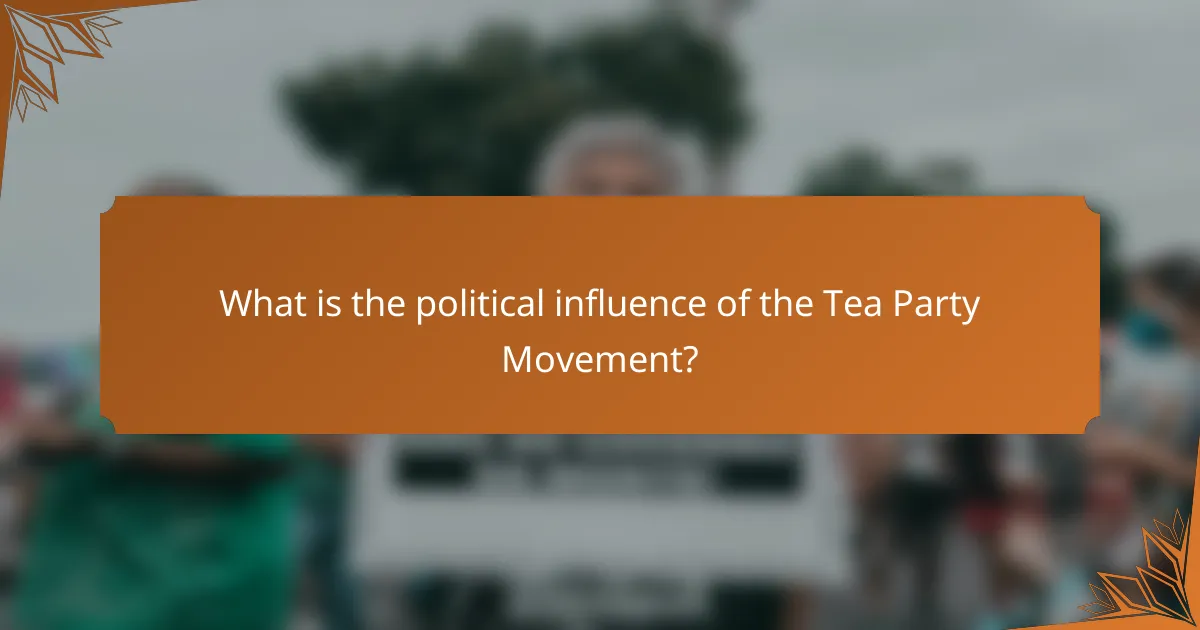
What is the political influence of the Tea Party Movement?
The political influence of the Tea Party Movement is significant in American politics. It emerged in 2009, primarily as a response to the policies of the Obama administration. The movement has been associated with advocating for limited government, lower taxes, and a strict interpretation of the U.S. Constitution. It played a crucial role in the 2010 midterm elections, helping to elect numerous conservative candidates to Congress. The movement has shifted the Republican Party further to the right. Its grassroots activism has mobilized many voters and influenced local and national elections. The Tea Party has also impacted legislative agendas, pushing for budget cuts and opposing healthcare reforms. Overall, its influence has reshaped the political landscape in the United States.
How has the Tea Party Movement impacted elections in the United States?
The Tea Party Movement significantly impacted elections in the United States by energizing grassroots activism. It emerged in 2009, primarily in response to government spending and taxation policies. The movement mobilized conservative voters, influencing the Republican Party’s platform. In the 2010 midterm elections, Tea Party candidates won numerous seats in Congress. This success led to a shift in the Republican Party towards more conservative positions. The movement’s emphasis on limited government resonated with many voters. Its influence continued in subsequent elections, shaping candidate selections and campaign strategies. Overall, the Tea Party Movement reshaped the political landscape by prioritizing fiscal conservatism and grassroots engagement.
What notable candidates have emerged from the Tea Party Movement?
Notable candidates from the Tea Party Movement include Ted Cruz, Rand Paul, and Marco Rubio. Ted Cruz, elected to the U.S. Senate in 2012, was a prominent figure advocating for limited government and fiscal conservatism. Rand Paul, also elected in 2010, emphasized individual liberties and a non-interventionist foreign policy. Marco Rubio, who gained national attention during his 2010 Senate campaign, focused on economic growth and conservative values. These candidates exemplified the movement’s influence on the Republican Party and its emphasis on grassroots activism.
How has the Tea Party influenced the Republican Party?
The Tea Party has significantly influenced the Republican Party by shifting its ideological stance towards more conservative policies. This movement emerged in 2009, primarily in response to President Obama’s administration and perceived government overreach. It mobilized grassroots activism, emphasizing limited government, fiscal conservatism, and strict adherence to the Constitution. The Tea Party’s influence led to the election of several conservative candidates during the 2010 midterm elections, resulting in a Republican majority in the House of Representatives. This shift also pressured established Republican leaders to adopt more hardline positions on issues like taxation and healthcare. Overall, the Tea Party reshaped the party’s platform and intensified the ideological divide within American politics.
What criticisms does the Tea Party Movement face?
The Tea Party Movement faces several criticisms. Critics argue it promotes extreme conservatism. This includes opposition to government intervention and social programs. Additionally, the movement is accused of fostering divisive rhetoric. Many believe it contributes to political polarization in the United States. Critics also highlight its ties to wealthy donors and corporations. This raises concerns about the influence of money in politics. Furthermore, some argue the movement’s policies disproportionately benefit the wealthy. This criticism suggests a lack of focus on middle and lower-income Americans. Overall, the Tea Party Movement is often viewed as out of touch with broader public needs.
How do opponents view the actions and beliefs of the Tea Party Movement?
Opponents view the actions and beliefs of the Tea Party Movement as extreme and divisive. Critics argue that the movement promotes a narrow interpretation of conservatism. They claim it undermines bipartisan cooperation in politics. Some see its anti-government stance as harmful to public services. Others argue that its rhetoric fuels social tensions. The movement’s emphasis on limited government is viewed as neglecting social welfare. Many opponents believe its grassroots tactics are manipulative. Overall, the Tea Party is often seen as a catalyst for polarization in American politics.
What evidence exists to support or refute claims against the Tea Party Movement?
Evidence exists both to support and refute claims against the Tea Party Movement. Supportive evidence includes instances of grassroots mobilization and significant electoral influence. For example, the Tea Party played a crucial role in the 2010 midterm elections, contributing to the Republican gains in the House of Representatives. This demonstrated their capacity to shape political outcomes.
Conversely, claims against the Tea Party often highlight allegations of extremism and racism. Studies, such as one by the Pew Research Center, indicate that a portion of the movement’s supporters hold views that align with exclusionary or nativist ideologies. Additionally, some critics argue that the movement’s rhetoric fosters divisiveness.
These contrasting pieces of evidence illustrate the complexity of the Tea Party Movement’s impact and the varying perceptions surrounding it.
What lessons can be learned from the Tea Party Movement?
The Tea Party Movement teaches several important lessons about grassroots political activism. First, it highlights the power of mobilizing ordinary citizens around shared concerns. The movement emerged in response to economic issues and government spending, reflecting widespread frustration. Second, it demonstrates the effectiveness of leveraging social media for organization and outreach. The Tea Party utilized platforms like Facebook and Twitter to connect and inspire supporters. Third, it underscores the significance of local engagement in shaping national policy. Local chapters played a crucial role in influencing elections and policy debates. Lastly, the movement illustrates the impact of ideological purity in political movements. The Tea Party prioritized conservative principles, which resonated with many voters. These lessons emphasize the potential of grassroots movements to effect change in political landscapes.
How can future political movements apply the strategies of the Tea Party Movement?
Future political movements can apply the strategies of the Tea Party Movement by focusing on grassroots organization and mobilization. The Tea Party effectively utilized local chapters to engage community members and encourage participation. Future movements should prioritize building a strong local presence to foster connections.
Additionally, the Tea Party emphasized clear messaging around key issues such as limited government and fiscal responsibility. Future movements can adopt similar concise messaging to resonate with their target audience. The Tea Party also leveraged social media for outreach and coordination. Future movements should utilize digital platforms to spread their message and organize events.
Moreover, the Tea Party’s strategy included forming coalitions with like-minded organizations to amplify their impact. Future movements can benefit from partnerships to broaden their reach. Lastly, the Tea Party demonstrated the importance of engaging in the electoral process, supporting candidates aligned with their values. Future movements should actively participate in elections to influence policy outcomes.
What best practices can be derived from the Tea Party’s successes and challenges?
Best practices derived from the Tea Party’s successes and challenges include grassroots mobilization, clear messaging, and strong local organization. Grassroots mobilization proved effective in rallying support and engaging citizens. The Tea Party utilized social media for outreach, enhancing communication and coordination. Clear messaging focused on limited government and fiscal responsibility resonated with many voters. This clarity helped unify diverse groups under a common purpose. Strong local organization facilitated rapid response to political developments. The Tea Party’s ability to influence primaries demonstrates the importance of targeting key elections. Additionally, maintaining a flexible strategy allowed adaptation to changing political landscapes. These practices highlight the significance of community engagement and strategic communication in political movements.
The Tea Party Movement is a conservative political movement in the United States that emerged in 2009, primarily in response to perceived government overreach and excessive spending. This article explores the origins, goals, and political influence of the movement, detailing its core beliefs centered around limited government, fiscal conservatism, and individual liberties. Key figures, historical events, and grassroots activism are discussed, highlighting the movement’s significant impact on elections and the Republican Party. Additionally, the article addresses criticisms faced by the Tea Party and the lessons learned from its strategies and challenges.
